NavSource Online: Submarine Photo Archive
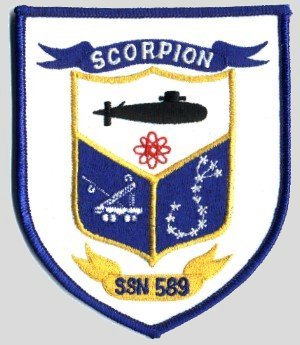

Patch on left contributed by Mike Smolinski, Decal on right by unlimiteddetails.com
Scorpion (SSN-589)

![]()
![]()
![]()
![]()
Skipjack Class Attack Submarine: Laid down, 20 August 1958, at the Electric Boat Division, General Dynamics Corp., Groton, CT.; Launched, 19 December 1959; Commissioned, USS Scorpion (SSN-589), 29 July 1960; Last reported position, 21 May 1968, about 50 miles south of the Azores. Six days later, she was reported overdue at Norfolk; Crew declared "presumed lost," 5 June 1968; Struck from the Naval Register 30 June 1968; Final Disposition, in October 1968 Mizar (T-AGOR-11) located sections of Scorpion's hull in more than 10,000 feet of water about 400 miles southwest of the Azores. Subsequently, the Court of Inquiry was reconvened but, despite the myriad of data and pictures collected and studied, the cause of the loss remains a mystery.
Specifications: Displacement, Surfaced: 2,880 t., Submerged: 3,500 t.; Length 251' 9"; Beam 32'; Draft 28 ft.; Speed, Surfaced 15 kts, Submerged 30+ kts; Depth Limit 700'; Complement 118; Combat Systems, Sonar, BQR-12, BQR-2 passive, BQS-4 (modified) active/passive; Radar BPS-12; Fire Control, MK-101 torpedo FCS, ASW MK-48; Armament, six 21" torpedo tubes, forward; Propulsion System, one S5W nuclear reactor, two Westinghouse steam turbines, one propeller 15,000 shp.
10 December 2010
From: B. Rule, 3931 Brookfield Ave, Louisville, KY 40207-2001 To: VADM David J. Dorsett, Director of Naval Intelligence, Office of Naval Intelligence, 4251 Suitland Road, Washington, DC 20395-5720
Subj: Why the Scorpion (SSN-589) Was Lost on 22 May 1968
When the US nuclear submarine Scorpion was lost in the east central Atlantic on 22 May 1968, the event produced a series of acoustic signals detected by underwater sensors on both sides of the Atlantic.
By comparing the detection times of these signals, the position of the Scorpion was determined. That position provided the basis for the search that identified the Scorpion wreckage.
The first reanalysis of these acoustic signals in 40-years, in combination with conclusions drawn in 1970 by the Scorpion Structural Analysis Group (SAG), has provided the following new information:
- The initiating events that caused the loss of Scorpion were two explosions with an energy yield of not more than 20-lbs of TNT each. These explosions, which occurred one-half second apart at 18:20:44 Greenwich Mean Time (GMT) on the 22 May 1968, were contained within the Scorpion pressure-hull,
- Based on the examination and microscopic, spectrographic and X-ray diffraction analysis of a section of the Scorpion TLX-53-A main storage battery cover recovered by the U.S. submersible, Trieste-II, the SAG determined the battery exploded before flooding of the battery well occurred.
- Collectively, the acoustic data and the physical evidence confirm Scorpion was lost because of two explosions that involved the ignition of hydrogen out gassed by the battery, i.e., these explosions were the initiating events responsible for the loss of Scorpion.
- These explosive events prevented the crew from maintaining depth-control. The Scorpion pressure-hull and all internal compartments collapsed in 0.112-seconds at 18:42:34 GMT on 22 May 1968 at a depth of 1530-feet. The energy yield of that event was equal to the explosion of 13,200 lbs of TNT, the essentially instantaneous conversion of potential energy (680 psi sea pressure) to kinetic energy, the motion of the water-ram which entered the pressure-hull at supersonic velocity.
- The more than 15 acoustic events that occurred during the 199-second period following pressure-hull collapse were produced by the collapse of more pressure-resistant structures, including the six torpedo tubes, within the wreckage.
- Reanalysis of the acoustic data also confirmed:
(1) Scorpion did not reverse course to deal with a torpedo conjectured to have become active in its launch tube;
(2), there were no acoustic detections of either a torpedo or any other naval surface ship or submarine when Scorpion was lost,
(3), there were no explosive events external to the Scorpion pressure-hull.
In summary, Scorpion was lost because two battery-associated explosions created onboard problems the crew could not overcome. There was no Soviet involvement.
This information has been provided to the Chief of Naval Operations, OPNAV N87, the Office of Naval Intelligence (ONI), Commander Submarine Forces, and the Naval History and Heritage Command.
Source: analysis of acoustic data that has been in the public domain for over 40-years.
Analyst: B. Rule, for 42-years, the lead acoustic analyst at ONI, the national laboratory for passive acoustic analysis.
Text courtesy of Chuck Haberlein.[Former Director of the Naval History and Heritage Command]
| Click On Image For Full Size | Size | Image Description | Contributed By | |
|---|---|---|---|---|
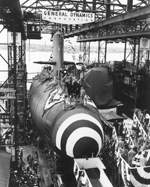 |
841k | Skipjack (SS-585) about to slide down the launching ways at General Dynamics Corp., Electric Boat Division, Groton, CT., 26 May 1958. I believe the Scorpion (SSN-589) is under construction on the right. |
USN photo courtesy of Scott Koen & ussnewyork.com. | |
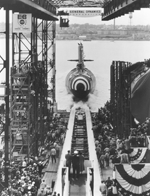 |
729k | Skipjack (SS-585) is waterbourne on 26 May 1958. I believe the Scorpion (SSN-589) is under construction on the right. |
USN photo # NPC 710183, courtesy of Scott Koen & ussnewyork.com. | |
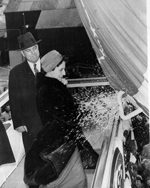 |
321k | Mrs. Elizabeth Morrison christening the Scorpion (SSN-589). Mrs. Morrison was the daughter of CDR Maximilian G. Schmidt, commanding officer of Scorpion (SS-278) at the time it was lost during WWII. | Photo courtesy of Dale Hargrave. | |
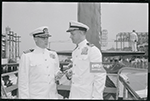 |
283k | (Original Caption) Groton, Conn.: Capt. Paul R. Schratz, USN, (L), only surviving member of the crew of the World War II submarine Scorpion (SS-278) presents the Commissioning Pennant of the sub to the skipper, Cmdr. Norman B. Bessac, of the nuclear powered sub Scorpion (SSN-589) during commissioning ceremony at the General Dynamics Shipyard in Groton, 7/29. Capt. Schratz of Pittsburgh, Pa., was transferred from the Scorpion just before it was lost in action. | Collection: Bettmann/Getty Images courtesy of gettyimages.com. | |
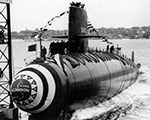 |
243k | With her bow wrapped in the bunting of the constellation bearing her name, the Scorpion (SSN-589) slides down the ways at the Electric Boat Division, General Dynamics Corp., Groton, CT. 19 December 1959. | USN photo. | |
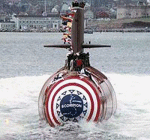 |
22k | The Scorpion (SSN-589) is waterborne following her launching at the Electric Boat Division, General Dynamics Corp., Groton, CT. 19 December 1959. | Photo courtesy of Bill Gonyo. | |
 |
357k | The beginning of Scorpion (SSN-589) as a commissioned warship, 29 July 1960. The Triton (SSRN-586) is seen behind her. Following her post-shakedown availability, Triton assumed her duties as a radar picket submarine in August 1960. | Partial text courtesy of DANFS. USN photo # USN 1051824 courtesy of Scott Koen & ussnewyork.com. | |
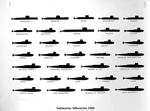 | 179k | Submarine Silhouettes of 1960: Nautilus (SSN-571), Seawolf (SSN-575), Skate (SSN-578), Skipjack (SS-585), Triton (SSRN-586), Halibut (SSGN-587), Thresher (SSN-593), Tullibee (SSN-597), George Washington (SSBN-598), & Ethan Allen (SSBN-608) classes. | USN photo submitted by Ron Titus, courtesy of Ingersoll-Rand. Corp. | |
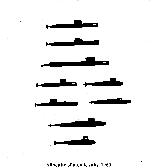 | 187k | Nuclear Submarine Profiles 1960: Nautilus (SSN-571), Seawolf (SSN-575), Triton (SSRN-586), Skate (SSN-578) & Skipjack (SS-585) classes, Halibut (SSGN-587) & Tullibee (SSN-597) classes, George Washington (SSBN-598) & Thresher (SSN-593) classes. | USN photo courtesy of Ron Titus courtesy of Ingersoll-Rand. Corp. Photo i.d. courtesy of David Johnston |
|
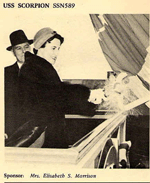 | 6.40k | Commissioning PDF for the Scorpion (SSN-589) & Court of Inquiry on her loss. | USN photo courtesy of Scott Koen & ussnewyork.com | |
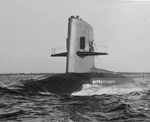 |
248k | (Original Caption) Plowing through the waters of Long Island Sound on her maiden voyage is the Scorpion (SSN-589), the Navy's newest atomic powered submarine. Standing on the diving plane are Vice Admiral Hyman G. Rickover, Lt. and Commander James F. Calvert, and the sub's skipper, Cmdr. Norman Bessac is on the bridge. Built by the electric boat division of General Dynamics, the Scorpion is a sister ship of the Skipjack (SSN-585), which the Navy says is the world's fastest submarine. | Photo by Bettman via Getty Images courtesy of gettyimages.com. | |
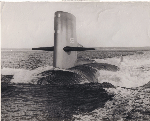 |
107k | Scorpion (SSN-589) possibly on 27 June 1960, off New London, CT., during builder's trials. | USN photo courtesy of Wendell Royce McLaughlin Jr. | |
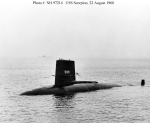 |
100k | Scorpion (SSN-589) photographed, 22 August 1960, off New London, CT. A "GUPPY" type submarine is faintly visible in the distance, just beyond the forward tip of Scorpion's "sail". | USN photo # NH 97214, from the collections of the Naval Historical Center. | |
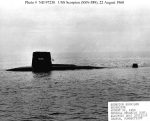 |
111k | Scorpion (SSN-589) photographed, 22 August 1960, off New London, CT. | USN photo # NH 97230, from the collections of the Naval Historical Center. | |
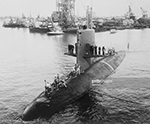 |
810k | Assigned to Submarine Squadron 6, Division 62, Scorpion (SSN-589) departed New London, Conn., on 24 August 1960 for a two-month deployment in European waters. During that period, she participated in exercises with units of the 6th Fleet and of other NATO navies. (Original Caption) Atomic Sub in England. Portsmouth, England: The first nuclear submarine ever to enter a British port, the U.S. sub Scorpion nears its berth in Portsmouth, England. The Scorpion was among many U.S. Navy vessels, most of which took part in the NATO exercise 'Fallex 60,' to make port in Portsmouth. While the nuclear sub is in Portsmouth, no one will be allowed near her and other boats will be kept away. |
Partial text courtesy of DANFS. Photo by Betttman/Getty Images courtesy of gettyimages.com. | |
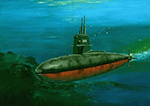 |
60k | Watercolour and gouache on paper painting by the artist Viktor Stepansky entitled "Diving Skipjack Class". The Skipjack Class (SSN-585 / 88-92) - clearing showing the tear-drop shape adopted by many of the submarine's successors. The Scorpion (SSN-589) is pictured here underway. |
Photo & text courtesy of subart.net. | |
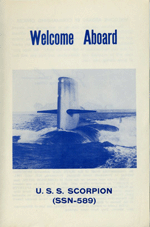 | 912k | Four page Welcome Aboard PDF for the Scorpion (SSN-589). | USN photo courtesy of Mike Smolinski. | |
 |
21k | A shipfitter measures the hull for a cofferdam to fit around an access hole to remove and install equipment, June 1963 to May 1964. The Scorpion (SSN-589) was the first nucelar sub to be overhauled by the Charleston, S.C. shipyard. | USN photo courtesy of Robert Hall. | |
 |
24k | Scorpion (SSN-589) logo on ship's mail, May 1964. | Courtesy of Richard Leonhardt. | |
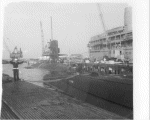 |
28k | Scorpion (SSN-589) in 1966 at D&S piers Norfolk Va. Cutlass (SS-478) and Orion (AS-18) in the background. | Courtesy of John Hummel, USN (Retired). | |
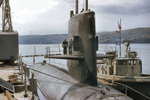 |
344k | Scorpion (SSN-589) on it's last Northern run in 1966. We were tied up at Holy Loch. | Photo courtesy of Bill Lee. | |
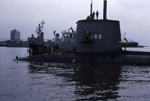 |
256k | The Scorpion (SSN-589) gets a helping nudge from the Marinette (YTB-791) entering Norfolk, Virginia. The Lawrence (DDG-4) is in the background. | Photo i.d. courtesy of Ron Reeves (of blessed memory) Photo courtesy of LCDR Nate Anderson, HSM-41, whose mother was married to Steven Johnson, Interior Communications Electrician, who was lost with the rest of the 99 man crew on 5 June 1968. | |
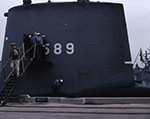 |
449k | The Scorpion (SSN-589) docked & crew descending at Norfolk, Virginia. | Photo i.d. courtesy of Ron Reeves (of blessed memory) Photo courtesy of LCDR Nate Anderson, HSM-41, whose mother was married to Steven Johnson, Interior Communications Electrician, who was lost with the rest of the 99 man crew on 5 June 1968. | |
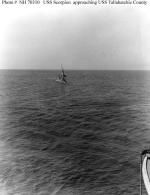 |
72k | Scorpion (SSN-589) approaches Tallahatchie County (AVB-2) in preparation for coming alongside, outside Claywall Harbor, Naples, Italy, 10 April 1968. | USN photo # NH 70310, from the collections of the Naval Historical Center, courtesy Lieutenant John R. Holland, Engineering Officer, Tallahatchie County, 1969. | |
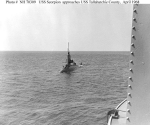 |
72k | Scorpion (SSN-589) prepares to come alongside Tallahatchie County (AVB-2) outside Claywall Harbor, Naples, Italy, 10 April 1968. | USN photo # NH 70309, from the collections of the Naval Historical Center, courtesy Lieutenant John R. Holland, Engineering Officer, Tallahatchie County, 1969. | |
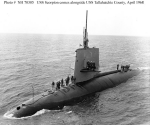 |
115k | Scorpion (SSN-589) comes alongside Tallahatchie County (AVB-2) outside Claywall Harbor, Naples, Italy, 10 April 1968. | USN photo # NH 70305, from the collections of the Naval Historical Center, courtesy Lieutenant John R. Holland, Engineering Officer, Tallahatchie County, 1969. | |
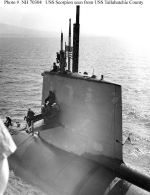 |
104k | Scorpion (SSN-589) comes alongside Tallahatchie County (AVB-2) outside Claywall Harbor, Naples, Italy, 10 April 1968. The submarine's Commanding Officer, Commander Francis A. Slattery, is atop her sail, holding a megaphone. | USN photo # NH 70304 from the collections of the Naval Historical Center, courtesy Lieutenant John R. Holland, Engineering Officer, Tallahatchie County, 1969. | |
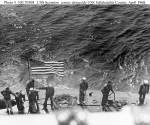 |
174k | Scorpion (SSN-589) ties up alongside Tallahatchie County (AVB-2) outside Claywall Harbor, Naples, Italy, 10 April 1968. This view shows the submarine's line handling crew aft of her sail, just as she has been made fast and the National Ensign transferred to its "in port" position. | USN photo # NH 70308, from the collections of the Naval Historical Center, courtesy Lieutenant John R. Holland, Engineering Officer, Tallahatchie County, 1969. | |
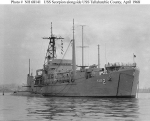 |
63k | Scorpion (SSN-589) alongside Tallahatchie County (AVB-2) outside Claywall Harbor, Naples, Italy, in April 1968, shortly before she departed on her last voyage. | USN photo # NH 68141, from the collections of the Naval Historical Center, courtesy Lieutenant John R. Holland, Engineering Officer, Tallahatchie County, 1969. | |
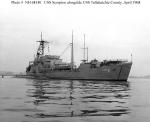 |
71k | Scorpion (SSN-589) alongside Tallahatchie County (AVB-2) outside Claywall Harbor, Naples, Italy, in April 1968, shortly before she departed on her last voyage. | USN photo # NH 68140, from the collections of the Naval Historical Center, courtesy Lieutenant John R. Holland, Engineering Officer, Tallahatchie County, 1969. | |
 |
347k | Scorpion (SSN-589) alongside Tallahatchie County (AVB-2) outside Claywall Harbor, Naples, Italy, in April 1968, shortly before she departed on her last voyage. | Text courtesy of NH 68136 photo from the collections of the Naval Historical Center, courtesy Lieutenant John R. Holland, Engineering Officer, Tallahatchie County, 1969. USN photo courtesy of Scott Koen & ussnewyork.com. |
|
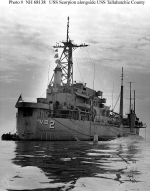 |
66k | Scorpion (SSN-589) alongside Tallahatchie County (AVB-2) outside Claywall Harbor, Naples, Italy, in April 1968, shortly before she departed on her last voyage. | USN photo # NH 68138, from the collections of the Naval Historical Center, courtesy Lieutenant John R. Holland, Engineering Officer, Tallahatchie County, 1969. | |
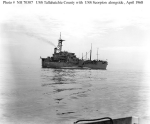 |
68k | Scorpion (SSN-589) alongside Tallahatchie County (AVB-2) outside Claywall Harbor, Naples, Italy, in April 1968, shortly before she departed on her last voyage. | USN photo # NH 70307, from the collections of the Naval Historical Center, courtesy Lieutenant John R. Holland, Engineering Officer, Tallahatchie County, 1969. | |
| Discovery | ||||
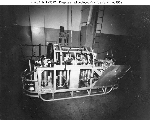 |
69k | "...... Side view of the towed sled used by the Navy research ship Mizar (T-AGOR-11) in the search for the nuclear submarine Scorpion (SSN-589). Various types of search and detection equipment can be mounted on this vehicle. Mizar yesterday located objects identified as portions of the hull of the Scorpion at a depth of more than 10,000 feet, about 400 miles southwest of the Azores." Quoted from the original caption, released with this photograph under date of 31 October 1968. | Official USN photo # NH 97577, from the collections of the Naval Historical Center. | |
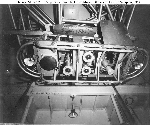 |
94k | "...... Bottom view of the towed sled used by the Navy research ship Mizar (T-AGOR-11) in the search for the nuclear submarine Scorpion (SSN-589). Various types of search and detection equipment can be mounted on this vehicle. Mizar yesterday located objects identified as portions of the hull of the Scorpion at a depth of more than 10,000 feet, about 400 miles southwest of the Azores." Quoted from the original caption, released with this photograph under date of 31 October 1968. | Official USN photo # NH 97578, from the collections of the Naval Historical Center. | |
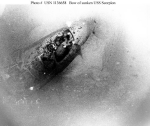 |
133k | View of the sunken submarine's bow section, on the Atlantic Ocean floor 10,000 feet deep, some 400 miles southwest of the Azores. Probably taken when Scorpion (SSN-589) was located by Mizar (T-AGOR-11) in October 1968. This image shows the top of the bow section, from the vicinity of the sail (which has been torn off)--at left-- to the tip of the bow--at top center. The torpedo room hatch is visible about half-way along the length of this hull section, with a lifeline track running aft from it. The original photograph bears the date 30 January 1969. | Official USN photo # USN 1136658, from the collections of the Naval Historical Center. | |
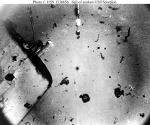 |
149k | View of the sunken submarine's sail, on the Atlantic Ocean floor 10,000 feet deep, some 400 miles southwest of the Azores. Probably taken when Scorpion (SSN-589) was located by Mizar (T-AGOR-11) in October 1968. This image shows the starboard side of the sail, with its after end at top left, and the starboard access door in lower left. Debris is on the ocean bottom nearby. The device in top center is part of the equipment used in locating and photographing the wreckage. The original photograph bears the date 30 January 1969. | Official USN photo # USN 1136656, from the collections of the Naval Historical Center. | |
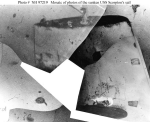 |
102k | "A mosaic of the sail of the Scorpion (SSN-589) showing the starboard side and starboard fair-water plane. Located at the top center is the periscope fairing and masts protruding from the sail. An access door is clearly visible in the center of the picture. The white area is an area not photographed in this mosaic." Probably taken when Scorpion (SSN-589) was located by Mizar (T-AGOR-11) in October 1968. The original photograph bears the date 30 January 1969. | Official USN photo # NH 97219, from the collections of the Naval Historical Center. | |
 |
98k | Section of the sunken submarine's hull, on the Atlantic Ocean floor 10,000 feet deep, some 400 miles southwest of the Azores. Probably taken when Scorpion (SSN-589) was located by Mizar (T-AGOR-11) in October 1968. This image shows the top of the hull, aft of amidships. The large oval opening is the stowage bay for the messenger buoy. Also visible are circular ballast tank vents, two rectangular access hatches into the superstructure and damaged snorkel exhaust piping. The original photograph bears the date 30 January 1969. | Official USN photo # USN 1136662, from the collections of the Naval Historical Center. | |
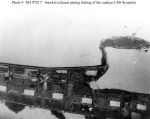 |
85k | "Damaged section of the Scorpion's (SSN-589) snorkel exhaust piping fairing. The rectangle white areas are zinc plates attached to the fairing to retard corrosion. This section is referred to as the 'turtle-back' of this class submarine." Quoted from the original photo caption, which bears the date 30 January 1969 | Official USN photo # NH 97217, from the collections of the Naval Historical Center. | |
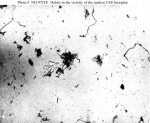 |
121k | "Debris located on the bottom of the ocean floor in the area 400 miles southwest of the Azores Islands where the Scorpion (SSN-589) was located." Quoted from the original photo caption, which bears the date 30 January 1969. | Official USN photo # NH 97218, from the collections of the Naval Historical Center. | |
 |
124k | Scorpion (SSN-589) 5th anniv cachet. | USN photo courtesy of Scott Koen & ussnewyork.com. | |
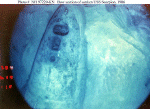 |
116k | "Atlantic Ocean (August 1986)....Depth 10,000 feet, 400 miles southwest of the Azores; view of the bow section of the nuclear-powered attack submarine Scorpion (SSN-589) where it rests on the ocean floor. Note the forward messenger buoy cavity and escape trunk access hatches." Quoted from the caption released with this photo in 1995. The view was taken by Woods Hole Oceanographic Institute. | Official USN photo # NH 97220-KN, from the collections of the Naval Historical Center. | |
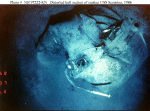 |
110k | "400 miles Southwest of the Azores: Forward compartment of Scorpion (SSN-589) where it rests on the ocean floor in more than 10,000 feet of water. ... A portion of a periscope protrudes from the hull; its shadow is visible on the hull." Quoted from the original photo caption, which is one of five views, dated August 1986, taken by Woods Hole Oceanographic Institute. This view looks down at the after end of the wreck's bow section with the port side toward the top. It shows massive structural distortion at and forward of the area where the hull separated. | Official USN photo # NH 97222-KN, from the collections of the Naval Historical Center. | |
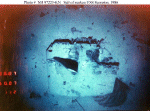 |
152k | Atlantic Ocean (August 1986)....Depth 10,000 feet, 400 miles southwest of the Azores; A view of the detached sail of the nuclear-powered attack submarine Scorpion (SSN-589) laying on the ocean floor. The starboard fair-water plane is visible protruding from the sail. Masts are visible extending from the top of the sail (located at the lower portion of the photograph). A large segment of the after section of the sail, including the deck access hatch, is missing. Various articles from the operations compartment are scattered in this vicinity." Quoted from the caption released with this photo in 1995. The view was taken by Woods Hole Oceanographic Institute. | Official USN photo # NH 97223-KN, from the collections of the Naval Historical Center. | |
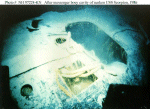 |
152k | "400 miles southwest of the Azores: The after messenger buoy cavity from the Scorpion (SSN-589) resting on the ocean floor in more than 10,000 feet of water. The messenger buoy is used to mark the position of the escape hatch of a distressed submarine. This area was also used to store mooring line, some of which is visible protruding from the hatch." Quoted from the original photo caption, which is one of five views, dated August 1986, taken by Woods Hole Oceanographic Institute. | Official USN photo # NH 97224-KN, from the collections of the Naval Historical Center. | |
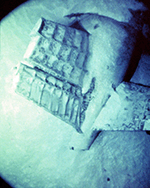 |
354k | Stern view of the nuclear-powered attack submarine Scorpion (SSN-589) showing the upper portion of the rudder (with draft markings) and the port stern plane. Note that the impact with the ocean floor has caused the after portion of the engine room section to be telescoped into the machinery room. The ribs of the stern planes can be seen due to the deformation of the metal covering then and display the massive force which was imparted to the ship upon impact with the sea bottom. | Official USN photo # DN-SC-95-00199 by Woods Hole Oceanographic Institute, courtesy of dodmedia.osd.mil, Defense Visual Information Center. | |
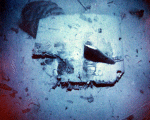 |
307k | Depth 10,000 feet, 400 miles southwest of the Azores; a view of the detached sail of the nuclear-powered attack submarine Scorpion (SSN-589) laying on the ocean floor. The starboard fair-water plane is visible protruding from the sail. Masts are visible extending from the top of the sail (located at the lower portion of the photograph). A large segment of the after section of the sail including the deck access hatch is missing. Various articles from the operations compartment are scattered in this vicinity. | Official USN photo # DN-SC-95-00200 by Woods Hole Oceanographic Institute, courtesy of dodmedia.osd.mil, Defense Visual Information Center. | |
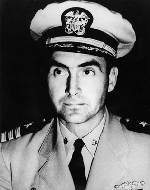 |
26k | Francis Atwood Slattery, Commander (Commanding Officer)of the Scorpion (SSN-589) at the time of her loss. | USN photo courtesy of oneternalpatrol.com. | |
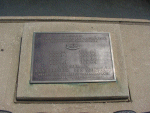 | 91k | Memorial plaque at Independence Seaport Museum, Philadelphia PA, July 2006 for the crews of United States submarines lost during peace time accidents: F-1 (SS-20), F-4 (SS-23), G-2 (SS-27), H-1 (SS-28), O-5 (SS-66), O-9 (SS-70), S-4 (SS-109), S-51 (SS-162), Squalus (SS-192), Scorpion (SSN-589) & Thresher (SSN-593). | Photo courtesy of Wendell Royce McLaughlin Jr. | |
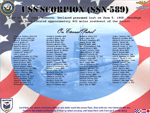 | 287k | Commemorative photo honoring the memory of the crew of the Scorpion (SSN-589). | Photo courtesy of Raymond Fritz. ET1(SS). | |
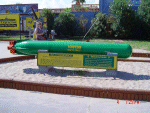 | 276k | Mk 37 Mod 2 torpedo of the type carried by the Darter (SS-576), and other submarines during the Cold War. A 19 inch diameter weapon powered by batteries, it swam out of the tube instead of the traditional impulse shot, making it hard for the enemy to detect. Early versions of this torpedo were notoriously finicky. An overheating battery that lead to an explosion is one of the leading theories of the loss of the Scorpion (SSN-589). During the 80's, the Darter normally carried two of these weapons in her after torpedo room, although up to four could be carried if two were tube loaded. Carried as a supplement to the normal load-out of Mk 48's in the forward torpedo room, they were mostly intended to be shot at pursuers during an evasion. The Darter had the honor of shooting the last Mk 37 exercise rounds during a Tactical Readiness Evaluation at Pearl Harbor in June, 1985. That same month she offloaded the last operational Mk 37 war-shots, sending them to storage. This particular weapon is part of the Lexington CVT-16 museum at Corpus Christi, Texas. | Photo by David Johnston (USN, retired) . | |
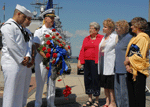 |
366k | The Scorpion Wives of the Skipjack class fast-attack submarine Scorpion (SSN-589) present a ceremonial wreath to Cmdr. Paul Snodgrass, commanding officer of the fast-attack submarine Boise (SSN-764), during the 40th Anniversary Memorial Service aboard Naval Station Norfolk on 24 May 2008. The following text is from The Coming Fury by Bruce Catton., pg. 478. "Major Sullivan Ballou of Rhode Island was killed in the battle, and just before it he had written to his wife, Sarah, to tell her that he believed he was going to be killed and to express a tremulous faith that could see a gleam of light in the dark: "But O Sarah! If the dead can come back to this earth and float unseen around those they loved, I shall always be near you in the gladdest days and in the gloomiest nights, always, always, and if there be a soft breeze upon your chest it shall be my breath, as the cool air fans your throbbing temple it shall be my spirit passing by. Sarah, do not mourn me dead; think I am gone and wait, for we shall meet again!" |
USN photo # N-8655E-003 by Mass Communication Specialist 2nd Class Kelvin Edwards, courtesy of news.navy.mil. | |
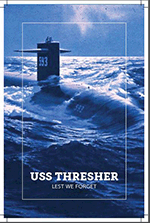 | 457k | 32 page PDF on Thresher's (SSN-593) memorial flagpole. Also a PDF on Information and Security Issues Associated with the Loss of the Thresher and Information on the Loss of the Scorpion (SSN-589) as it Relates to the Loss of Thresher. | PDF courtesy of Bob Hurley, Charles Tompkins & Ron Reeves (of blessed memory) | |
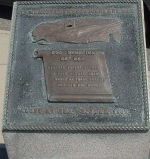 |
135k | Scorpion (SSN-589) memorial in NOB Norfolk VA.
The Thresher sank during the deep dive portion of Phase C Sea Trials in April 1963. Quite a bit was known (and later discovered) about the Thresher disaster. Sadly, the same cannot be said of the sinking of the Scorpion (SSN-589). The Scorpion was lost during a mission in 1968 and while the U.S. Government convened inquiries, it has never issued any official explanation or cause of the loss, and instead has left the door open to several theories. This lack of closure is a void that has over the years been filled by poorly researched cloak-and-dagger accounts of the loss of the Scorpion. The following is a copy of a letter written by Neal Collier to the Scorpion Families on the Scorpion-99 Yahoo Group. It was written in response to the most recent of these un-official' accounts. It is reprinted here because it contains some Thresher-related information, but more importantly to show that these two ships, the men that were lost, and the families and loved-ones left behind are inexorably linked in history past, present, and future. For the Scorpion 99, John Howland I was 4 when my father was lost on the Thresher (SSN-593) . He had transferred on as the Engineer's relief just prior to Sea Trials. I don't think he was even part of the crew for more than a few weeks. I went in to the Navy myself many different reasons and ended up on the Archerfish (SSN-678), meeting the boat in the Med. After about a year we went to the Portsmouth Naval Shipyard (PNS) for an overhaul. The PNS was where the Thresher had undergone her last overhaul, and from which she went on her last dive. While there I took the opportunity to speak to a LOT of SY Workers and Navy types. I discovered that the PNS took the Thresher sinking very seriously and take the hard-earned lessons to heart in everything they do. The Shipyard lost officer observers and civilian Shipyard workers when the Thresher sank. Many people forget that. Each and every person that I spoke to who worked on her or remembered her was reduced to tears when we discussed the tragedy. So what happened? Why did the Thresher sink? The sad fact is that usually the reason bad things happen is that humans are involved and humans, well, they make a lot of mistakes. For the Thresher, there were so many mistakes made it is difficult to name them all. One that comes to mind is the depth of water in which she sank. Test Depth is a certain depth. It's classified, but for argument's sake let's say Test Depth is 400 feet. (It is deeper than that, but we'll use that in this example.) If you were conducting deep depth test and the boat could only go safely to 400 feet, you probably would want to be in water that was just a bit deeper than that. You would also want to have the ability to provide support if trouble occurred. The Thresher was on the way to Test Depth in water that was about 8400 feet deep and no rescue vessels were in the vicinity. Think about the monumental arrogance and stupidity that resulted in that location being chosen. There were others, but the gist here is that many, many mistakes were made. From that tragedy, though, came many positive changes. SUBSAFE was the big one. Design and operational changes occurred, too. - SUBASFE - A complex and comprehensive submarine overhaul maintenance and repair management system with checks and double-checks to ensure any / all critical operational and safety components are thoroughly tracked, tested, and checked after maintenance, repair, or modification prior to allowing them to be released for use. - Moisture separators on the High Pressure Air Compressors (HIPACS) to remove moisture known to cause the 'Venturi Effect' which freezes the Tank Emergency Main Ballast Tank Blow Valves when they are needed the most. - Prior to the Thresher disaster, submarines were routinely put through a gauntlet of depth charges causing structural damage that was then measured and evaluated. This is no longer done to operational vessels. - Fast SCRAM recovery. The ability to rapidly and safely bring the reactor (the steam source for the engines to turn the propeller) back from a shutdown state. - Equipment Cooling. Prior to the Thresher, equipment was cooled mainly from pipes that carried seawater through tubes that cooled the equipment. This meant that there were many feet of pipe throughout the sub carrying water at extreme pressures. Design changes were made to install large heat exchangers that transferred cold from the seawater to fresh water at much lower pressures. The fresh water was then pumped to the equipment to cool it. - Silver brazing and radiography. When pipe was cut and welded, a special silver braze was used to seal the weld and make it water tight. Silver welding was hard to get right and many welds were not able to withstand the pressures to which they were subjected. This practice was ultimately stopped. In addition, very few welds were looked at using radiography (think of the dentist looking at your teeth). Taking radio-graphic pictures of critical welds is now done (and in some cases re-done) for all piping and hull welds. The above are a few major examples. I hasten to add that the Thresher did not 'create' these changes; they (and many more) were already being studied, debated, and discussed at the time. The Thresher was only the catalyst to make them happen; to push it through Congress. I do not know a lot about the Scorpionbut have read a few books and accounts. From a Scorpionperspective, I think the article from Proceedings (July 1998) summed it up as the Navy just did not learn the lessons from the Thresher. A stuck Trash Disposal Unit (TDU) valve was postulated as the most probable reason the Scorpion was lost. A guy I knew on the Shark (SSN-591) (sister ship to the Scorpion) said that TDU valve got stuck on a mission and the Captain would not let anyone touch it until they got into port. They must have been teaching that as a potential problem at Prospective Commanding Officer's (PCO) School. People just like the sexy conspiracy stuff, I guess. Revenge for the sinking of the .... Wait a minute. What, now? Our culture loves a good story and we want so desperately to believe the unbelievable. When in Orlando at a Navy service school I heard of the "Thresher Tape" where supposedly members of the crew left messages to loved ones that the Skylark (a recording and communications ship) picked up before she sank. I heard this from many different people at different commands. I searched at several different commands in a vain attempt to find that recording. It took me until years after I got out of the Navy to come to the realization that it was baloney. A family friend (USNA '56) explained it to me this way "OK, the ship is sinking. Are you going to work like heck to fix it, or are you going to line up outside the Radio Room to record a message?". I was at a Naval awards ceremony a few years back and a female officer (LtCDR) informed me at the reception that her husband told her of a top secret mission where the Thresher actually had SEALS on board during Phase C Sea Trials. I have to tell you, had I said to her what I was actually thinking at the time, I probably would have been thrown off that base. There are other examples (too many, unfortunately). People who you would think know better don't. There are all these crazy theories and stories. Thankfully, there are no books written about the Thresher (except maybe the Polmar book), so I don't have to go through that. I was recently lent a book about the 'secret' submarine war by a co-worker who is also ex-Navy. After a quick scan I was not happy with what I read and did a web search on the book. The results (poorly researched, mostly fiction, etc.) confirmed my suspicions. I spoke to the guy who lent it to me, explaining how I would feel if idiots who actually believe the tripe sent out via emails wrote a book about some plot against the Soviets involving the Thresher; involving these noble men who gave their lives for their country; cheapening their memory and honor for a few bucks, for some fame, for --- what exactly? When I told my co-worker this he leaned back in his chair and said very humbly, "I hadn't thought of that."The crazy theories and stories make me sick and angry, to be honest. They create a false and phantom history and in my view move the discussion farther away from where it needs to be: how can we create a stronger and safer submarine force and never NEVER let this kind of tragedy happen again? OK. I have said enough. As a closer I would say that we need to be vigilant, to keep the memories alive, and to stay true to our loved ones and their memory through memorial services and discussions. We need to keep the memory of those lost and how they were lost alive for this and future generations. 1 - "Those who don't know history are destined to repeat it." Edmund Burke (1729-1797) 2 - We honor those who we love and respect. When we stop doing that we lose our humanity. 3 - Memorial services give those who have not grieved the opportunity to do so when they are ready. Sincerely, Neal Collier In Memorium: In the Second Book of Shmuel (Samuel), 22nd chapter, 5th through the 19th verses, translated from the original in Hebrew and published by the Koren Publishers of Jerusalem, Israel, can perhaps aptly describe the fate of the crew and all other U.S.sailors who died defending their county: "When the waves of death compassed me / the floods of ungodly men made me afraid; / the bonds of She'ol encircled me; / the snares of death took me by surprise; / in my distress I called upon the Lord, / and cried to my G-D: / and he heard my voice out of his temple, / and my cry entered into his ears. / Then the earth shook and trembled; /the foundations of heaven moved / and shook because of his anger /...the heavy mass of waters, and thick clouds of the skies /... And the channels of the sea appeared, / the foundations of the world were laid bare, / at the rebuking of the Lord, at the blast at the breath of his nostrils. / He sent from above, he took me; / he drew me out of many waters; / he delivered me from my strong enemy, and from those who hated me; for they were too strong for me. / They surprised me in the day of my calamity: / but the Lord was my stay..." | Text courtesy of Neal D. Collier. Photo courtesy of Wendell McLaughlin. Dante's Prayer courtesy of Loreena McKennitt via loreenamckennitt.com |
|
| Commanding Officers | |||
| 01 | CDR. Bessac, Norman Bagnall USN (USNA 1945) | 29.07.1960 - 30.03.1962 First Date in Commission | |
| 02 | CDR. Kaufman, Robert Young (Yogi), USN (USNA 1946) :VADM | 30.03.1962 - 12.08.1963 | |
| 03 | CDR. Ghormley, Ralph McDougall, USN (USNA 1949) :RADM | 12.08.1963 - 22.07.1965 | |
| 04 | LCDR. Lewis, James Richard, USN :RADM | 22.07.1965 - 17.10.1967 | |
| 05 | CDR. Slattery, Francis Atwood, USN (USNA 1954) | 17.10.1967 - 22.05.1968 | |
View the Scorpion (SSN-589)
DANFS history entry located on the Haze Gray & Underway Web Site.
Crew Contact And Reunion Information
U.S. Navy Memorial Foundation
Fleet Reserve Association
Additional Resources and Web Sites of Interest
On Eternal Patrol
USS Scorpion (SSN-589)
Scorpion and Thresher Wreckage Video
decklog.com/SSN-589
FAS - SSN-585 Skipjack Class
| Back To The Main Photo Index | Back To the Submarine Index |
|
Problems and site related matters, E-mail Webmaster |
|
This page is created by Gary Priolo and maintained by Michael Mohl All Pages © 1996 - 2022, NavSource History All rights reserved. |